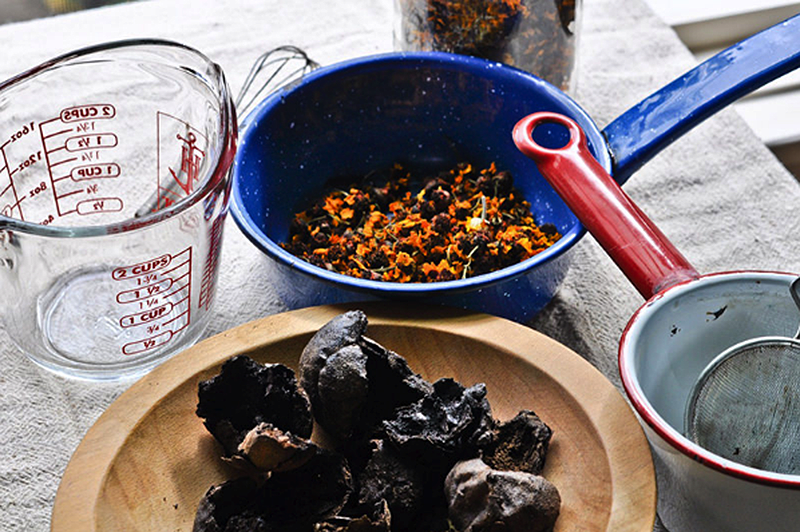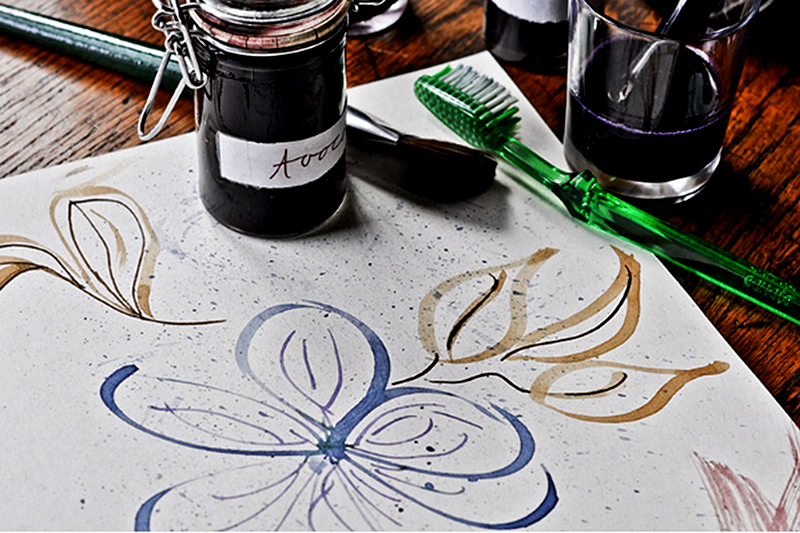
I’ve been dying wool yarn with plants from my property and the roadside for years, and a few years ago, when I had abundance of black walnuts in my backyard, I made black walnut ink. However, I never really thought about making colored inks from anything else, even though any plants produce strong colors that can be used not only for dying yarn and fabrics, but for painting on paper, canvas or walls; for printing; or as inks for writing or brushwork.
Today, we pick up a ballpoint pen or felt-tip marker and never think twice about how that ink got in the pen or what it’s made from. Dipping a quill or pen into a bottle of ink may seem a bit old-fashioned, and probably not something you want to do on a daily basis, but it can be a fun summer project for the kids or art project for yourself.
General Instructions

In the recipes, we’re producing only a small amount of ink—about 3 or 4 ounces—so it doesn’t take a lot of plant material or time, leaving you room to experiment with a lot of different colors. Then you can mix the inks to produce even more colors. You will need only a few specialty items from the craft store or dye supplier to make the inks last longer and not fade quickly:
- Mordant: Some natural dyes, including black walnuts, onion skins, tea or turmeric, are called substantive, meaning they don’t require a mordant to bind with the fibers or retain wash and light fastness. However, most other plants do. Mordants are generally tannins or mineral salts. The most common and safest mordants are alum and iron. Iron can be obtained by boiling the dye in an iron skillet or adding a rusty piece of iron to the pot. Soda ash is also known as washing soda or sodium carbonate. It is an alkaline mordant and will bring out different colors from the plant material.
- Gum Arabic: This is used to thicken the liquid. It helps the ink flow onto the paper in a controlled fashion and binds the ink with the paper. It will also help preserve the color.
- Thyme Oil: This is used to help prevent mold from forming in the ink.
Below, you’ll find recipes for several different colors of ink, but the process of making each one is basically the same. Simmer 1 cup of fresh or 1/2 cup of dried plant material with 1 cup of water and a mordant (if necessary) for 20 to 30 minutes. Strain out the plant material. You should have about 3-4 ounces of liquid. Whisk in 1/2 teaspoon gum Arabic while the ink is still warm so it dissolves easily, and let it cool. Pour the cooled ink into a small bottle and add 3 drops of thyme essential oil. The ink is ready to use to write or draw.
Colored-Ink Recipes

It’s always fun to see what color inks plants will produce—it’s not always what you might think. Creamy colored avocado pits can produce a red or pink dye. The magenta colored leaves of the red shiso make a magenta liquid, but oxidize on paper into beautiful blue ink. Even the black raspberry ink, which starts out as a blue, changes over the course of a couple weeks to a purple. Some plants strike more quickly—the color comes out within a couple minutes of simmering—while others strike more slowing, taking lower heat and long simmering to reach it’s full potential. Making ink is just one more way to enjoy the beauty and excitement of our natural world.
Coreopsis Ink
- 1/2 cup dried coreopsis blooms (coreopsis tinctoria)
- 1 cup water 1 teaspoon alum
- 1/2 tsp. gum Arabic
- 3 drops thyme essential oil
Simmer the dried flowers with the water and alum for 20 minutes. Strain out the flowers. You should have about 4 ounces of liquid. Whisk in the gum Arabic until it is dissolved. Cool and pour into a small bottle. Add 3 drops of thyme oil and shake a couple times to mix.
Avocado Pit Ink
- 2 large fresh avocado pits, chopped into small pieces
- 1 cup water
- 1 teaspoon soda ash
- 1/2 tsp. gum Arabic
- 3 drops thyme essential oil
Simmer the avocado pits and soda ash in the water for 20 minutes. Strain out the pits and whisk in the gum Arabic. Cool and pour into a small bottle. Add the thyme oil and shake to mix.
Black Raspberry Ink
- 1 cup fresh black raspberries
- 1/2 cup water
- 1 tsp. alum
- 1/2 tsp. gum Arabic
- 3 drops thyme essential oil
Cook the raspberries with the water and alum for 15 minutes, mashing the berries to release the juice. Strain out the berries and whisk in the gum Arabic until dissolved. Cool and pour into a small bottle. Add 3 drops of thyme oil and shake to combine.
Black Tea Ink
- 1/2 cup tea leaves
- 1 cup water
- 1/2 tsp. gum Arabic
- 3 drops thyme essential oil
Boil the tea leaves and water for 15 minutes. Strain out the tea leaves and whisk in the gum Arabic. Cool and pour into a small bottle. Add the thyme oil and shake to combine.
Black Walnut Ink
- 1/2 cup dried walnut hulls
- 1 cup water
- 1/2 tsp. gum Arabic
- 3 drops thyme essential oil
Boil the walnut hulls with water for 30 minutes. Strain out the hulls and whisk in the gum Arabic. Cool and pour into a small bottle. Add the thyme essential oil and shake to combine.




